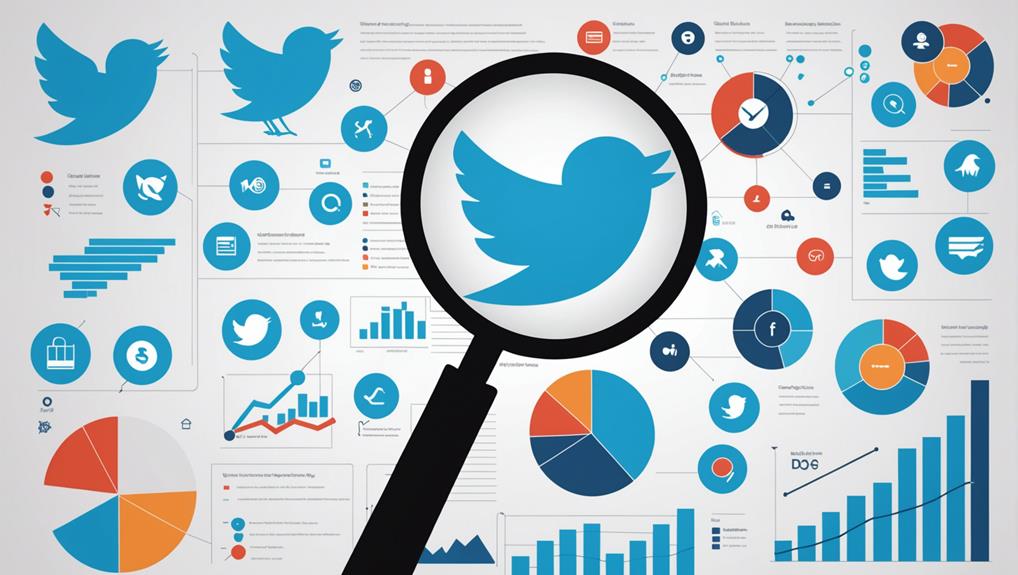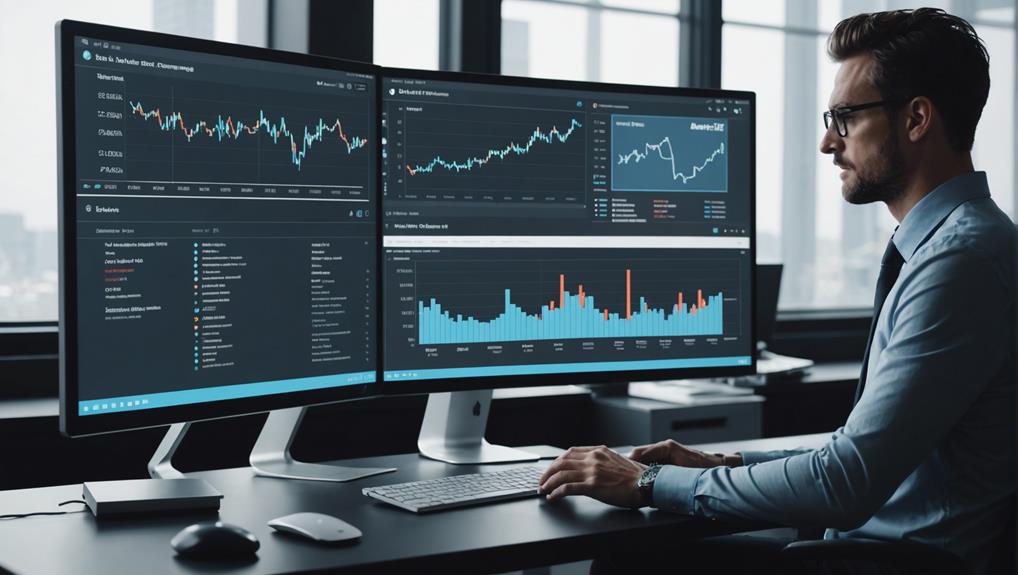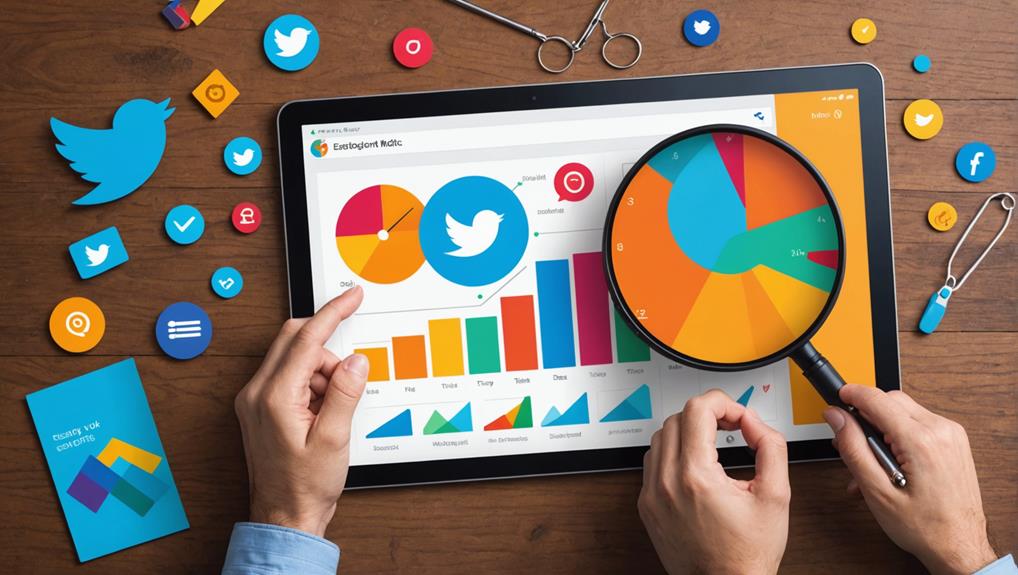Analyzing Twitter hashtag success requires leveraging specific tools tailored for engagement and sentiment analysis. Notable tools like Keyhole and Sprout Social provide extensive insights into likes, retweets, and comments for gauging effectiveness. Hashtagify and Talkwalker offer real-time data that aids in monitoring hashtag performance instantly, crucial for trend analysis. Free options such as TweetBinder and BrandMentions cover essential metrics without cost. For brands aiming to enhance strategy, tools with sentiment analysis like Brand24 are essential for understanding audience perceptions. By integrating these tools into your strategy, you’ll uncover the metrics driving impactful social media campaigns.
Key Takeaways
- Sprout Social offers detailed analysis of engagement metrics, tracking likes, retweets, and comments effectively for hashtag success.
- Keyhole provides real-time tracking and sentiment analysis, offering insights into audience perception of hashtags across segments.
- Talkwalker delivers immediate insights into hashtag performance with robust real-time analytics and trend analysis.
- Hashtagify provides free real-time analytics and suggestions to enhance engagement and reach for Twitter hashtags.
- BrandMentions analyzes dynamic social media conversations, offering comprehensive analytics across multiple platforms without financial investment.
Importance of Twitter Hashtag Analytics
Harnessing the power of Twitter hashtag analytics is crucial for brands aiming to refine their social media strategies and maximize engagement. By delving into engagement metrics, companies can measure the effectiveness of their hashtags, determining which ones resonate most with audiences. This analysis of hashtag performance is essential, as it offers a window into audience behavior, enabling brands to tailor their social media strategy to align with consumer interests.
Insights into hashtag usage reveal trending topics, allowing businesses to adjust their content strategies and increase brand visibility. Monitoring hashtags becomes a strategic exercise, providing key data points—such as frequency, reach, and sentiment—that inform data-driven decisions. This process not only bolsters brand awareness but also enhances the precision of campaign targeting based on real-time insights.
Moreover, understanding audience demographics through Twitter hashtag analytics allows for the refinement of messaging, leading to improved engagement and higher conversion rates. The continuous monitoring of hashtag success guarantees that brands remain agile and competitive, adapting their strategies proactively in response to shifting trends and competitor activities.
Ultimately, leveraging such analytics empowers brands to make informed, strategic decisions that drive success in the ever-evolving social media landscape.
Choosing the Right Tool
When selecting a Twitter hashtag analysis tool, it is vital to prioritize platform compatibility to guarantee seamless integration across all necessary social media channels.
Real-time data availability is essential for capturing up-to-the-minute trends and audience behavior, thereby enabling timely strategic decisions.
Additionally, focusing on tools that offer robust engagement metrics such as likes, retweets, and comments will provide valuable insights into the effectiveness of hashtags in fostering interaction and driving campaign success.
Platform Compatibility Check
Selecting the appropriate Twitter hashtag analysis tool hinges on guaranteeing platform compatibility to maximize the reach and effectiveness of your marketing campaigns. A versatile tool should support major platforms like X/Twitter, Instagram, LinkedIn, and TikTok, enabling thorough insights across your marketing strategy.
Twitter analytics tools that offer real-time tracking and historical analytics are essential for effectively monitoring hashtag performance. This guarantees you can adapt strategies based on current trends and past data. Additionally, real-time notifications for hashtag mentions allow marketers to stay updated on engagement metrics and audience interactions.
Consider the following to evoke an emotional connection with your audience:
- Empowerment: Choose tools that provide thorough insights, allowing you to make informed decisions that drive success.
- Efficiency: Real-time tracking guarantees you can swiftly react to changes in hashtag performance, optimizing your approach.
- Confidence: With robust monitoring, you’ll feel assured that your strategies align with audience interests and trends.
- Cost-effectiveness: While free tools offer basic analytics, investing in paid versions can reveal advanced features and broader tracking capacities.
Ultimately, evaluating engagement metrics and reporting features is vital for understanding the impact of hashtags on social campaigns, guaranteeing you select the tool that best meets your analytical needs.
Real-Time Data Availability
In the fast-paced landscape of social media marketing, real-time data availability emerges as a vital factor for optimizing hashtag performance and engagement strategies. By leveraging real-time tracking capabilities, marketers can effectively monitor hashtag usage and swiftly engage with trending Twitter hashtags. This immediacy allows for a proactive approach to audience interactions, enhancing the potential for meaningful engagement.
Analytics tools such as Talkwalker and Hashtagify excel in providing real-time tracking, enabling users to observe hashtag performance as it unfolds. Such tools deliver notifications on real-time hashtag mentions, empowering marketers to address audience sentiment and capitalize on immediate engagement opportunities. This is essential for maintaining relevance in dynamic social media environments.
Moreover, extensive reporting features found in platforms like Brand24 and Sprout Social allow for an in-depth hashtag analysis by integrating real-time metrics with historical data. This holistic approach aids in developing a nuanced understanding of hashtag effectiveness and engagement metrics over time.
For those seeking cost-effective solutions, free tools like TweetBinder offer the capability to analyze up to 200 tweets from the past week. This provides immediate insights into current engagement metrics and trending conversations, equipping marketers with valuable data to refine their strategies.
Engagement Metrics Focus
A marketer’s strategic edge in the competitive domain of Twitter rests on the ability to effectively analyze engagement metrics, which serve as a barometer for hashtag success. By focusing on detailed analytics, marketers can refine their Twitter marketing strategies, ensuring their content resonates with audiences.
Monitoring tools like Sprout Social and Keyhole are invaluable, providing real-time tracking of likes, retweets, and comments, which are critical indicators of hashtag performance. These tools offer insights that help assess audience engagement and the overall impact of a hashtag strategy.
To evoke a deeper understanding, consider these four compelling reasons to prioritize engagement metrics in your Twitter analysis:
- Identify Top-Performing Content: Engagement metrics reveal which posts captivate audiences, guiding future content creation.
- Optimize Hashtag Strategy: Understanding hashtag performance through thorough analytics enables marketers to adjust their tactics for maximum reach.
- Enhance Audience Interaction: Tools like Hashtagify deliver insights into engagement rates, supporting efforts to boost audience engagement.
- Track Hashtag Spread: With Tweet Reach, marketers can quantify how far their hashtags travel across the platform, ensuring strategic alignment with goals.
Regularly leveraging these social media analytics tools provides marketers with the insights needed to drive successful campaigns and improve hashtag performance.
Free Hashtag Tracking Tools
Maneuvering the landscape of social media marketing, free hashtag tracking tools have emerged as valuable assets for businesses and individuals aiming to optimize their online presence.
These tools, such as Talkwalker and Hashtagify, provide real-time analytics and deep insights into hashtag performance, enabling users to refine their Twitter strategy. By offering trend analysis and hashtag suggestions, they empower marketers to improve hashtag engagement and broaden their content reach.
Real-time analytics are essential for brand monitoring, allowing users to monitor and analyze dynamic conversations that shape the social media ecosystem.
BrandMentions further enhances this capability by delivering thorough analytics across multiple platforms. This feature guarantees users can visualize hashtag usage trends without the burden of financial investment.
Similarly, TweetBinder offers the ability to analyze up to 200 tweets from the past week, delivering succinct reports that highlight key engagement and reach metrics.
Meanwhile, Inflact and StarNgage, while focusing on Instagram, provide valuable insights that can indirectly influence Twitter strategies by suggesting relevant hashtags and evaluating their performance.
These free tools offer strategic advantages by facilitating the identification of trending topics and optimizing content strategies, thereby driving meaningful engagement and expanding brand visibility.
Key Features of Top Tools
In evaluating the key features of top Twitter hashtag analysis tools, real-time tracking capabilities and sentiment analysis insights emerge as critical components.
Tools like Tagbox and Tweet Binder offer robust real-time tracking, enabling businesses to monitor hashtag performance instantaneously and adjust their strategies accordingly.
Meanwhile, Keyhole’s sentiment analysis feature provides brands with valuable insights into audience sentiment, allowing for a nuanced understanding of how hashtags are perceived across different audience segments.
Real-Time Tracking Capabilities
Harnessing the power of real-time tracking capabilities, hashtag analysis tools have become indispensable for marketers aiming to optimize their social media strategies.
Real-time tracking in hashtag analytics tools offers immediate insights into the performance of hashtags by allowing users to explore engagement metrics as they unfold on the Twitter feed. Tools such as Talkwalker and Keyhole provide real-time notifications that keep marketers informed of hashtag mentions, enabling them to effectively monitor hashtag activity and engage with audience interactions promptly.
This immediate insight facilitates strategic decision-making by allowing marketers to assess hashtag performance and make timely adjustments.
Visual analytics and reports generated by these tools summarize complex real-time data, offering a strategic overview of hashtag effectiveness. Tools like TweetBinder further enhance this by analyzing up to 200 tweets from the past week, presenting a snapshot of recent hashtag activity.
The inclusion of visual analytics aids in the rapid assessment of campaign success, streamlining the process of identifying trends and making data-driven adjustments.
Consider the following advantages of real-time tracking:
- Immediate insight into engagement
- Prompt reaction to trends
- Effective audience interaction
- Strategic data-driven decisions
In today’s fast-paced digital world, such capabilities are essential for maintaining a competitive edge.
Sentiment Analysis Insights
Building on the robust capabilities of real-time tracking, sentiment analysis emerges as a vital component in understanding audience engagement on Twitter. This analytical feature, integral to tools like Brand24 and Keyhole, provides a nuanced view of audience feelings towards specific hashtags. By evaluating sentiment—be it positive, negative, or neutral—marketers can gauge hashtag performance and refine their marketing campaigns accordingly.
These insights play a significant role in shaping data-driven decisions, helping brands to optimize their strategies and enhance their reputation on social media.
In addition to Brand24 and Keyhole, platforms such as Sprout Social and Meltwater enhance Twitter analytics by categorizing mentions based on emotional tone. This categorization aids in understanding public perception, informing strategic response plans that align with audience sentiment.
Tweet Binder, another key player, correlates sentiment metrics with engagement metrics, offering a thorough view of how sentiment influences interaction rates. This correlation allows marketers to measure the effectiveness of campaigns holistically.
Conducting Hashtag Analysis
Effective hashtag analysis is a strategic process that begins with the meticulous selection of relevant hashtags, followed by the use of specialized analytics tools such as Tweet Binder and Keyhole for thorough performance tracking.
These tools are indispensable in hashtag analytics on Twitter, enabling users to monitor key metrics like reach, engagement, and sentiment. By leveraging these insights, brands can refine their content strategy and enhance social media monitoring efforts.
Harnessing historical data is vital for understanding past performance trends, which in turn identifies ideal posting times and enhances engagement rates.
To achieve hashtag success, consider the following strategic approaches:
- Track performance metrics: Use analytics tools to measure reach, engagement, and sentiment for informed decision-making.
- Leverage historical data: Analyze past trends to enhance content strategy and posting times effectively.
- Monitor competitors: Regularly review competitors’ hashtag usage to gain insights and identify successful industry trends.
- Discover trending hashtags: Utilize tools like Hashtagify and BrandMentions to track trends and discover related tags to boost visibility.
Understanding the dynamics of hashtag types is vital for optimizing Twitter marketing strategies. Each hashtag type serves a unique purpose, influencing hashtag performance and audience engagement.
Branded Hashtags are unique identifiers for companies, enabling marketers to measure brand awareness and track user-generated content. By analyzing these hashtags, marketers can fine-tune their marketing strategy to enhance audience interaction.
Event Hashtags are important during conferences and live events, as they drive real-time conversations and allow businesses to monitor attendee engagement.
Campaign Hashtags, on the other hand, are significant for specific marketing initiatives. They not only promote campaigns but also encourage user participation, making it easier to evaluate the effectiveness of a marketing strategy through detailed hashtag analytics.
Content Hashtags categorize posts by themes, optimizing hashtag usage for content discoverability and audience interaction. By evaluating the performance of these hashtags, marketers can strategically enhance engagement levels.
Finally, Trending Hashtags offer brands the opportunity to join popular discussions, expanding their reach and engaging a broader audience.
Enhancing Your Strategy With Analytics
Leverage the power of analytics to enhance your Twitter marketing strategy by utilizing advanced tools that offer thorough insights into hashtag performance. Tools like Sprout Social and Keyhole empower social media management by providing real-time insights into engagement metrics such as likes, retweets, and impressions. This allows you to effectively track hashtags and refine your hashtag campaigns for improved audience interaction and brand awareness.
By conducting audience analysis through Twitter analytics tools, you can tailor your marketing strategy to resonate with specific demographic segments, thereby increasing campaign effectiveness. Historical data analysis from tools like Tweet Binder uncovers seasonal trends and ideal posting times, ensuring your hashtag usage aligns with peak audience activity.
Consider these strategic advantages:
- Enhanced Engagement: Real-time performance metrics allow for immediate adjustments to improve user interaction.
- Targeted Messaging: Audience analysis enables messaging that resonates with specific demographics, increasing relevance and impact.
- Ideal Timing: Historical data helps identify the best times for hashtag campaigns, maximizing reach and engagement.
- Competitor Insights: Monitoring competitor hashtag strategies through tools like BrandMentions reveals potential gaps and opportunities for growth.
Frequently Asked Questions
How Do You Analyse Hashtags on Twitter?
To analyze hashtags on Twitter, assess hashtag engagement, trending topics, and audience insights through reach analysis, sentiment analysis, and competitor analysis. Monitor campaign tracking, frequency metrics, user demographics, and content strategy to enhance visibility and interaction.
What Is the Hashtag Research Tool for Twitter?
A Twitter hashtag research tool provides data analytics for understanding hashtag trends and audience engagement. It enhances brand visibility and content strategy through social listening, competitive analysis, and influencer impact, optimizing campaign performance and leveraging user-generated content effectively.
What Tool Does Twitter Measure Results?
Twitter Analytics provides thorough insights into hashtag engagement and trending topics. By offering audience insights, sentiment analysis, and competitive benchmarking, it aids in refining content strategy, evaluating campaign performance, measuring influencer impact, and understanding engagement metrics.
How Do I Monitor My Hashtag Performance?
To monitor hashtag performance, employ tools offering real-time monitoring and visual analytics. Evaluate hashtag engagement, audience reach, sentiment analysis, and influencer impact. Analyze competitor comparisons and trend tracking to refine content strategy and assess campaign effectiveness strategically.
Conclusion
The strategic utilization of Twitter hashtag analytics tools is essential for optimizing social media engagement and campaign performance. By selecting appropriate tools—whether free or premium—based on key features and analytical capabilities, organizations can conduct thorough hashtag analysis. Monitoring various types of hashtags enables the extraction of actionable insights, facilitating data-driven decision-making. Ultimately, enhancing social media strategies through meticulous analysis not only boosts visibility but also fosters meaningful connections with target audiences, thereby driving overall success in digital marketing efforts.




